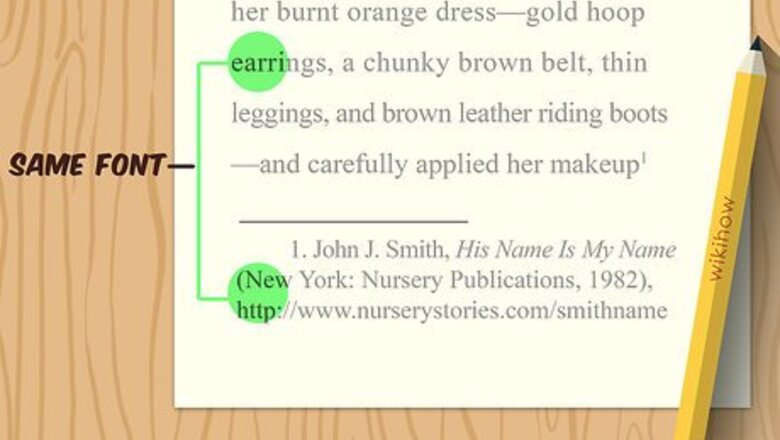
views
X
Research source
Formatting
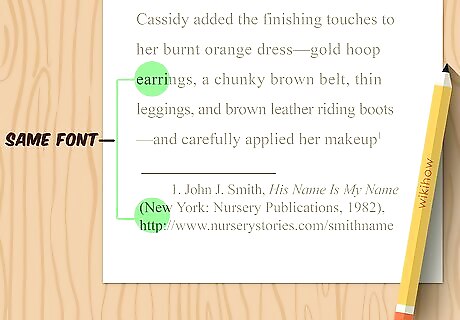
Use the same font for footnotes as the rest of the paper. Generally, you should use the same font for your entire paper rather than using several different fonts. The default font on your word processing app is usually fine. Tip: Footnotes are typically a smaller font size than the main text of your paper. Typically, you won't need to change the default size on the word processing app you're using to write your paper – it will do this automatically when you create a footnote.

Place the footnote number after closing punctuation. In most cases, a footnote occurs at the end of the sentence with the information that you want to cite or discuss. Some style guides provide for a number after the closing punctuation, followed by a period. In others, superscript numbers are preferred. You'll typically only have one footnote per sentence. If you need more than one footnote, place the other footnote at the end of the sentence clause it relates to, outside the closing punctuation. The only exception is if the sentence is broken up by a long dash, in which case, the superscript number goes before the beginning of the dash. Footnote Number in Line with Text: It is well known that patients who suffer from Crohn's and Colitis can have many debilitating symptoms. 1. Superscripted Footnote Number: It is well known that patients who suffer from Crohn's and Colitis can have many debilitating symptoms.
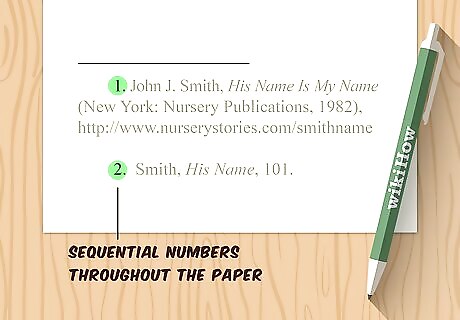
Use sequential numbers for footnotes throughout your paper. Footnote numbers count up from "1" throughout your paper – they do not start over at the beginning of each page. Each footnote has its own number, even if it is citing the same source as a previous footnote. For some longer papers, such as doctoral theses, footnote numbers may start over with each chapter. If you're unsure if this is appropriate for your project, discuss it with your editor or advisor. Most word processing apps will maintain sequential numbering for you, provided you use the app's function for inserting footnotes, rather than trying to type the numbers manually.

Insert footnotes using your word processing app. Most word processing apps have a function you can use to easily add footnotes to your paper. This function is usually included under the "insert" or "references" listing on your app's menu bar. You typically have formatting options that allow you to choose numbers, letters, or other symbols to indicate footnotes. You can also change the size or placement of footnotes, although the default option is usually appropriate.
Placing Citations
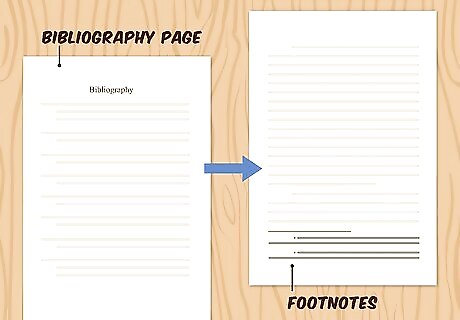
Write your bibliography page before placing footnotes. Citations in footnotes typically are shortened versions of the full citation that can be found in your bibliography or Works Cited at the end of your paper. Writing out the full citation first makes it easier to create your footnotes, and ensures that you've included all sources you used. For most style guides, the use of footnotes does not replace the need for a list of references at the end of your paper. Even if a full list of references isn't strictly required, it can help place your paper in context.

Type a citation for the source following the appropriate style guide. While the basic information included in a citation is almost always the same, different style guides have slightly different formats. Generally, you'll list the author's name first, followed by the title of the source. Include publication information, then close with the page number where the material you quoted or paraphrased appears. For example, suppose you've paraphrased information from a book by Reginald Daily, titled Timeless wikiHow Examples: Through the Ages. If you were using Chicago style, your footnote citation would look something like this: Reginald Daily, Timeless wikiHow Examples: Through the Ages (Minneapolis: St. Olaf Press, 2010), 115.
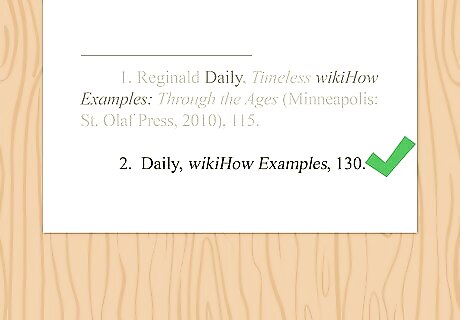
Use shortened citations for subsequent uses of the source. Often, you'll cite to the same source more than once in the same paper. You typically only have to give the full footnote citation for the source once. Later citations include the author's last name, a shortened version of the title, and the page number where the material you quoted or paraphrased can be found. For example, suppose later on in your paper you need to cite Reginald Daily's wikiHow book again. Your shortened citation might look something like this: Daily, wikiHow Examples, 130.Tip: Some citation styles recommend using the abbreviation "id." or "ibid." if you cite to the same source in footnotes immediately following. Others, notably the Chicago Manual of Style, require the use of a shortened citation instead.

Separate multiple citations with semi-colons. Sometimes, a sentence requires a citation to more than one source. Place a single footnote at the end of the sentence and include the citations to both sources in the same footnote, rather than having 2 footnotes at the end of the sentence. For example, suppose you have a sentence in your text comparing the conclusions in Reginald Daily's book with the observations in another book on the same topic. Your footnote might look something like this: Reginald Daily, Timeless wikiHow Examples: Through the Ages (Minneapolis: St. Olaf Press, 2010), 115; Mary Beth Miller, The wiki Revolution (New York: New Tech Press, 2018), 48.
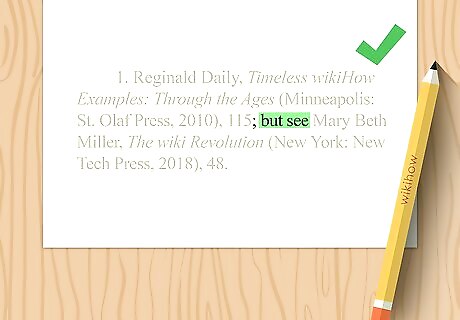
Include signal phrases to explain relationships between sources. Signal words and phrases, such as "but see" or "see also" let your readers know that there are other authors who agree or disagree with the information in the original source you cited. Typically, you would use the additional source to establish the relative reliability of the source you cited. For example, if Miller's work reached a conclusion that was contrary to the conclusion Daily reached, your footnote might look something like this: Reginald Daily, Timeless wikiHow Examples: Through the Ages (Minneapolis: St. Olaf Press, 2010), 115; but see Mary Beth Miller, The wiki Revolution (New York: New Tech Press, 2018), 48. If you believe it would be helpful to your readers, you can add a brief parenthetical comment after the second source that explains why you included it.
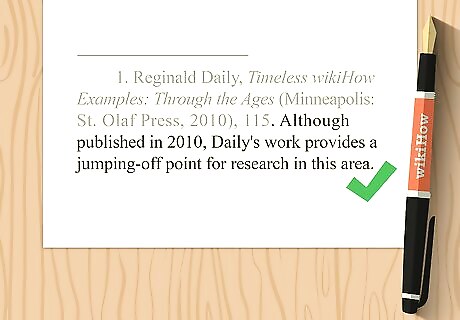
Add contextual information if necessary. A citation footnote may include nothing but the citation. However, occasionally you may need to explain something about the source or its relation to your paper. For example, suppose you want to include a brief explanation as to why you're citing Daily's book, despite the fact that it was published in 2010. Your footnote might look something like this: Reginald Daily, Timeless wikiHow Examples: Through the Ages (Minneapolis: St. Olaf Press, 2010), 115. Although published in 2010, Daily's work provides a jumping-off point for research in this area.
Supplementing Text
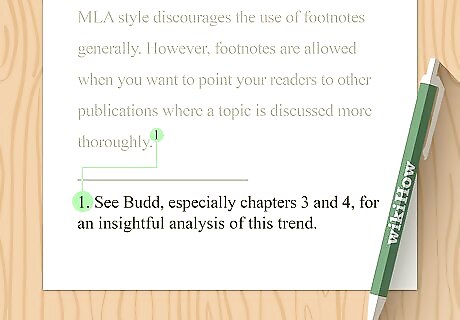
Include bibliographic notes in MLA papers. MLA style discourages the use of footnotes generally. However, footnotes are allowed when you want to point your readers to other publications where a topic is discussed more thoroughly. For example, there may be a basic concept that is beyond the scope of your paper, but important for your readers to understand. You could add a footnote that says "For an explanation of the theory of relativity, see generally" followed by a source or list of sources. Typically, these types of footnotes provide your reader with information on something that is tangential to your paper but could be important to help your readers understand the topic as a whole or place your paper in context.
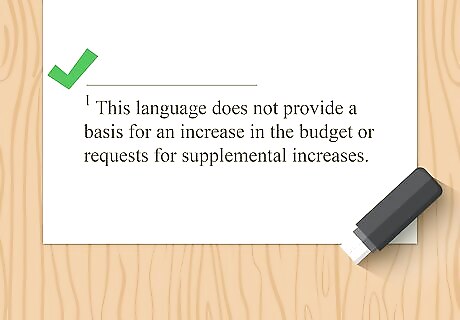
Use footnotes for asides that would ruin the flow of your writing. Tangential or parenthetical comments can interrupt your main text and potentially confuse readers. If you want to make a side comment about something, put it out of the way in a footnote so it doesn't distract readers from the point of your paper. Some style guides, such as MLA and APA, instruct that parenthetical statements should be included in the main text of your paper, rather than in footnotes.Tip: Keep your footnotes as brief as possible, especially with supplemental footnotes. Don't stray too far off topic or go into a tangent that is only marginally related to the topic of your paper.
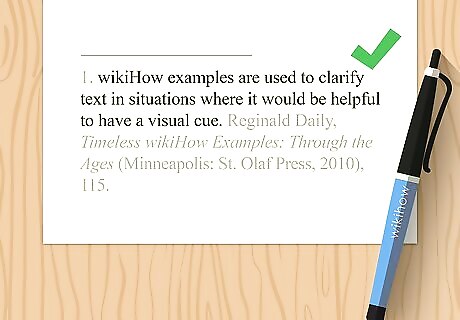
Provide working definitions, explanations, or clarifications. Sometimes you need to provide additional information so that your readers will understand exactly what a source means. You might also need to explain the significance of something mentioned in your source that isn't common knowledge. These types of footnotes frequently accompany a quote from a source and may include a citation to the source. For example, if you quoted a source that discussed wikiHow, and you wanted to clarify, you might add a footnote that says "wikiHow examples are used to clarify text in situations where it would be helpful to have a visual cue. Reginald Daily, Timeless wikiHow Examples: Through the Ages (Minneapolis: St. Olaf Press, 2010), 115."
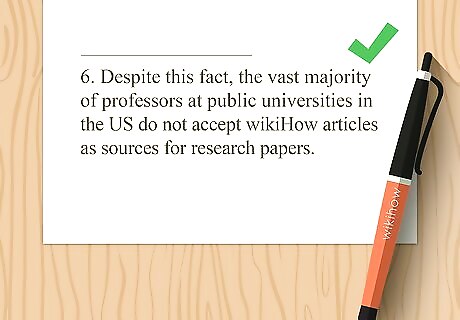
Offer quotes or additional commentary to give your paper depth. Sometimes a source may include a quote that you find particularly compelling, but that you just can't fit into your main text. There might also be information in your text that you want to make a comment about that is beyond the scope of your paper. For example, suppose you are writing a paper about the use of wikiHow articles as sources, and you include a study finding that wikiHow articles are more accurate than articles on major news sites about similar topics. You might add a footnote that says "Despite this fact, the vast majority of professors at public universities in the US do not accept wikiHow articles as sources for research papers." You can also use footnotes to make a witty remark, which can add humor and lightheartedness to your paper. However, these types of footnotes should be used extremely rarely, and only when appropriate to the subject matter.


















Comments
0 comment